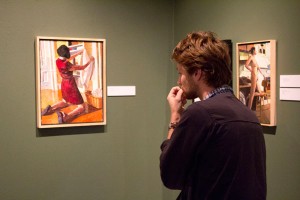The figure is one of the most fundamental parts of human existence. Artists spend lifetimes studying it. They learn its different lines, angles, curves and shades. Then they spend the rest of their career drawing, painting and experimenting, all just to find ways of interpreting it.
The latest exhibit at the Handwerker Gallery displays this eternal quest and all its possibilities.

The exhibit, called “The Figure,” is a guest exhibition created by the Midwest Paint Group. It’s a disconnected hodgepodge of works that explore the human body.
The collection is missing a clear perspective and vision of the body — an inherent effect of showcasing so many artists — but is nonetheless an interesting look at all that can be created when an artist looks at the human form.
The display of the pieces has an appealing flow. The exhibit begins to the left of the gallery with drawings done on paper with charcoal by Glen Cebulash, Lester Goldman and George Rose. These pieces are abstract and full of dark slashing lines to the point that push the onlooker to search for the faces and bodies among them. In one moment it’s all clear, but if the observer loses focus in the next, the figure is gone.
The collection progresses to the works of Jeremy Long on the back wall. Done with oil on canvas, his most prominently presented pieces are an exploration of one woman — Colleen. The first and third painting are composed in a Van-Gogh-reminiscent style, with thick brush strokes and globs of paint on the canvas. The subject is plain, but the artist’s style carries the piece. The viewer is drawn into following each stroke’s progression through the painting.
The most striking of Long’s work is “Colleen in Hammock.” In this piece, Colleen lies relaxed on a hammock, surrounded by absurdity: A man and a boy hold the cloth of the hammock, a woman plays a flute and a man walks down into a hall. Despite these distractions, the viewer is drawn into the center of the painting, where the artist has painted himself staring at Colleen. His eyes are piercing as he looks only at her. Though the painting is not necessarily an interpretation of figure, it is still a worthwhile piece.
Moving through the gallery, the rest of the works are well-done, but are not particularly striking, until the painting by artist Glen Cebulash called “Three Figures.” As expected from its title, the piece is perfect for the exhibition’s theme. A large oil on canvas abstract painting, it is most intriguing in its simplicity. Up close, the painting shows a mess of pastel cubes in peach, green, pink tan and other skin-like colors. But from a few steps back, the forms of three women appears. Without any true markers of the human body, the three bodies are clear.
The exhibit continues with a mix of abstract and impressionist paintings of nudes, with three self-portraits of George Rose added to the mix. Though these seem a little random among the rest of the full-body subjects, they aren’t without merit as individual works.
At the back of the gallery, the works by Michael Neary are some of the most appealing deviations. His pieces — “Last Drop,” “Deb Standing” and “Nude on Green Cushions” — are executed with a real playfulness. They are painted with the forms of reality shifted ever-so-slightly, with the people’s faces distorted and their bodies in strange proportions.
With the pieces on the final wall, the collection ends just as it began, with small drawings made mostly with charcoal on paper.
Combining so many artists’ works, “The Figure” has many different perspectives to offer. However, as a collection, it lacks a congruency of vision, though the pieces have individual merit and make up an intriguing exhibit.
“The Figure” is on display until Oct. 17 at the Handwerker Gallery. Admission is free and open to the public.




